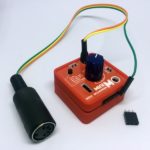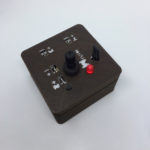I’ve just finished documenting the information on the Algorithmic Generator, which generates sound out of short lines of code! More…
Tag Archives: ATtiny85
New Program available – Chiptune Player
There’s a new program in the repository! It’s the Chiptune Player, which plays a list of tunes of up to four voices each, written in AMPLE notation. More…
MIDI Sequencer Updated – Slave Mode
I’ve just uploaded a revised version of the MIDI sequencer to the repository; this version adds a Slave mode, which allows the sequencer to advance steps on triggers sent by an external module. More…
New Program available – MIDI 12 Tone
I’ve added a new program to the repository, the MIDI 12 Tone, which generates chromatic scales and random 12-tone rows.
New Program available – MIDI Sequencer
I’ve uploaded a new program to the repository, a MIDI Sequencer that allows you to use miniMO as a pattern sequencer with any MIDI device.
New Program available – Display Example
There’s a new program in the repository, a Display Example, showing how to connect miniMO to OLED displays via I2C.
Manipulating Registers in AVR Microcontrollers
This guide aims to explain what registers are, and how to work with them. It applies to miniMO and the Arduino IDE but also to microcontrollers in general, and will be most useful to you if you can understand basic programs and would like to modify the setup of the timers or other peripherals within the microcontroller, but can’t make clear sense of lines like ADMUX |= (1 << ADLAR);
Build a 3D printed miniMO Noisette: step-by-step guide
miniMO is a reprogrammable synthesizer module designed to encourage everyone to try modular synthesis. Currently there are two models available: one is PCB-based with soldered components, whilst the other (code name Noisette) is built on 3D-printed parts and requires no soldering. I will show you how to assemble and program the latter model.More…
PWM, DAC, and timers on the ATtiny
miniMO’s brain is an Atmel AVR ATtiny85. This guide explains how to use ATtiny’s timers to create a train of pulses of variable width, itself translated into sound via a digital-to-analog converter.
Repository up and running
It’s here!
With five new modules up and running, I’ve revised and uploaded the DCO code to Github. It has been a while since I last used Github, since I normally work with svn; I was pleasantly surprised that I can use tortoiseSVN with it.
Following steps: decide on the open-hardware license, figure out ways to distribute it, publish a video demoing the unit, start modeling the case, and start spreading the word a bit more.


